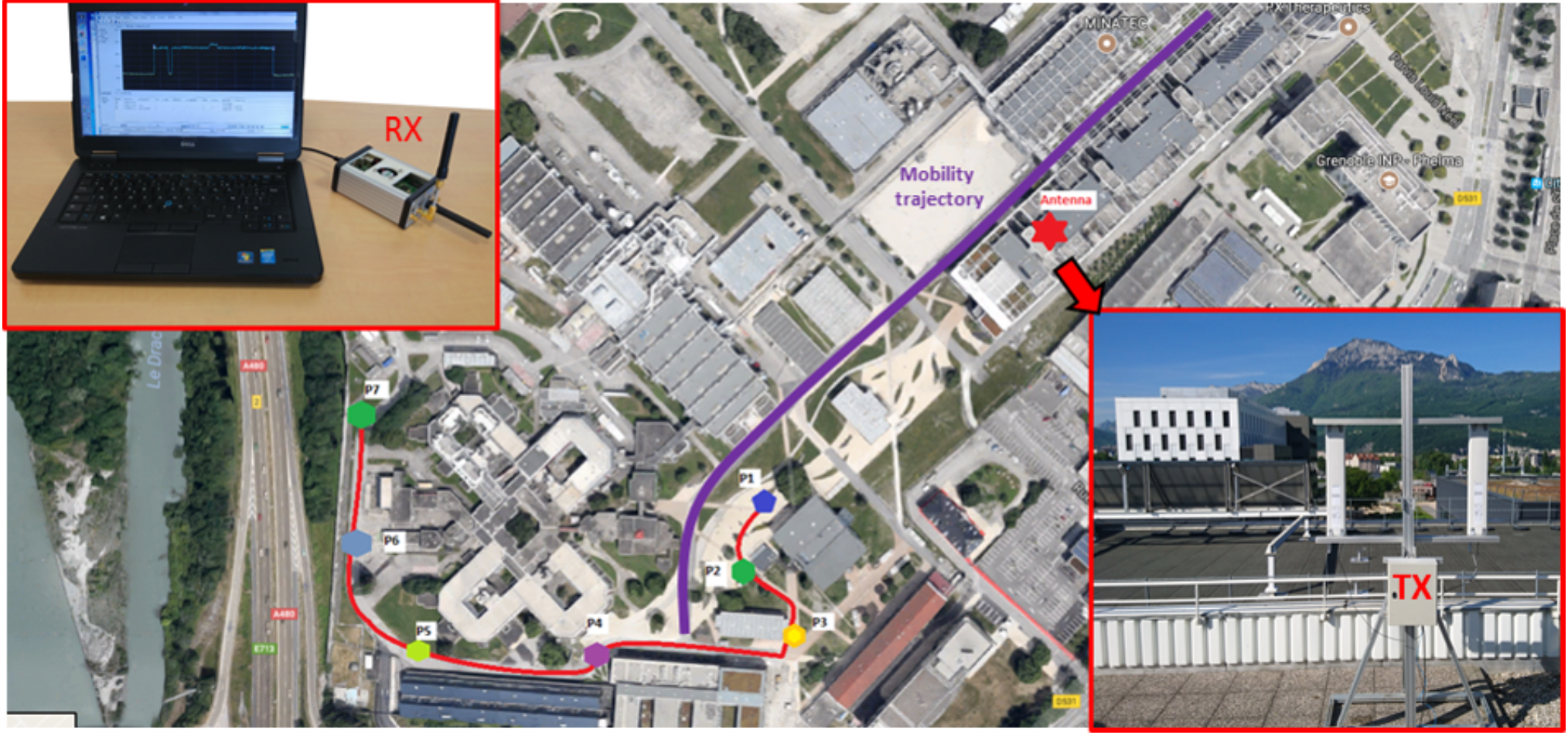© Robin Gerzaguet.
You can find here some aspects of my current or past research activities mostly on digital communication systems and architectures and software defined radios. Do not hesitate to reach me to have further informations on these projects.
I am always looking for highly skilled and passionate graduate students in those domains so if you feel that your are the special one, do not hesitate to contact me.
TEMPEST attacks target device that unintentionally emits sensible data through an electromagnetic channel. This kind of compromising are due to coupling, hardware impairments or physical proximity between components. Sensitive information emitted by these devices may be recovered passively by any radio component and more particularly by software defined radio, now capable to sample very large bandwidths.
The objectives of RedInBlack are many-folds
Assess new radio fingerprint based methods to identify devices through learning methods fed by large bandwidths features
Propose coherent and non-coherent decoding methods to recover the sensitive data emitted by the device
Develop effective methods able to cope with large bandwidths to identify TEMPEST channel and recover sensitive data in real time with the use of a new hardware/software methodology based on Julia language
Want to have more information ? Contact me or go to the RedInBlack website
In the context of deploying applications associated with the Internet of Things (IoT), embedded signal processing applications must be designed to operate with highly constrained computational resources. For IoT dedicated to monitoring natural environments, it is also important to minimize interactions and maintenance to avoid disturbing the natural environment. Typically, systems need to adapt their workloads to the available energy. In the case of intermittent architectures, the device can go offline and resume its activity when it regains energy. This paves the way for more complex computing processes on architectures that no longer have a battery but only a very low-capacity supercapacitor. Among the envisaged processes, using artificial intelligence techniques on the node presents major challenges, particularly in terms of memory management.
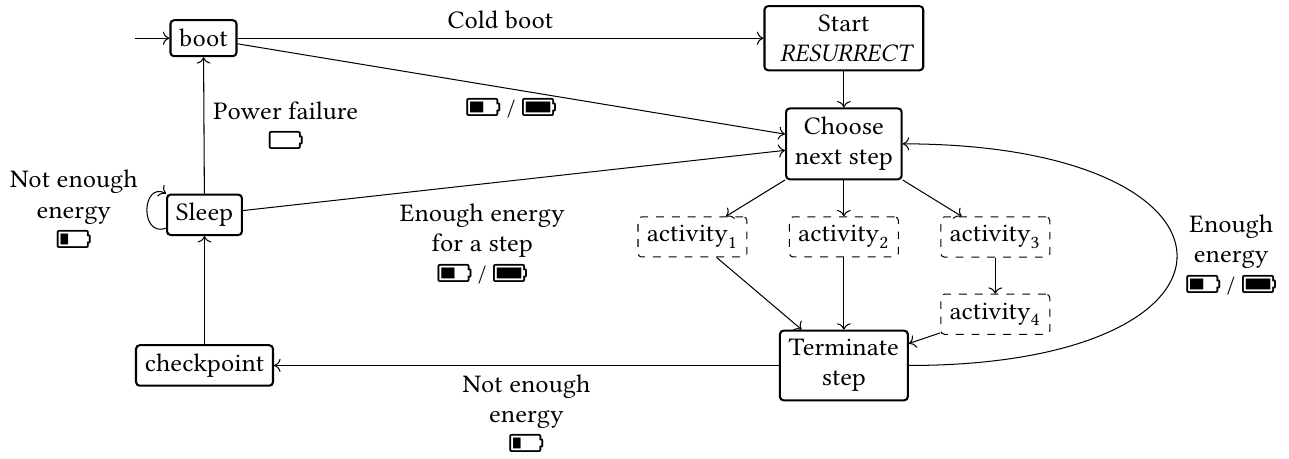
In the CominLabs project NOP, we aim to developp new intermittent architectures to improve the efficiency and usability of intermittent computing, based on consolidated theoretical foundations and a detailed understanding of energy flows within systems. For this, it brings together specialists in system architecture, energy-harvesting IoT systems, compilation, and real-time computing.
SDRs are immensely popular as they allow to have a flexible approach for sounding, monitoring or processing radio signals through the use of generic analog components and lot of digital signal processing. As, in this paradigm, most of the processing is done at software levels (i.e. on a CPU), an efficient software methodology has to be envisioned. Right now, most of the existing methods focus on low-level languages (C or C++) for good runtime performance (at the cost of easy prototyping) or high-level language (such as Python) for flexibility (at the price of runtime performance).
We propose a new methodology based on Julia language that addresses this two-language problem and paves the way for efficient prototyping without giving up runtime performance. To prove the benefits of the proposed approach, we have evaluated a performance benchmark with several optimisation levels and compares the Julia approach with C++ and Python.

We have also provide strong efforts to propose these tools to the community. The wrappers, comparisons and additional Julia tools are open source and can be find in the proposed Julia Telecom organisation.
Due to their flexibility and reconfigurability, software defined radios are now massively used as wideband transceivers, channel sounders or network gateways. However, they often struggle to meet the desired requirements in terms of energy consumption and throughput.
In HadOc project, we present a new architecture capable of tackling these challenges, by combining an on-the-shelf generic radio component with a low power microcontroller associated to a Fourier transform coprocessor. To prove the benefit of our approach, we have proposed a complete physical layer dedicated to audio broadcast applications. This chain is capable of streaming High Definition audio stream in real time with low power (437mW) and very low latency (854s). We have synthesized a (beautiful) board capable to stream high quality audio content with enormous autonomy of 80 hours (yeah, the battery is big) !
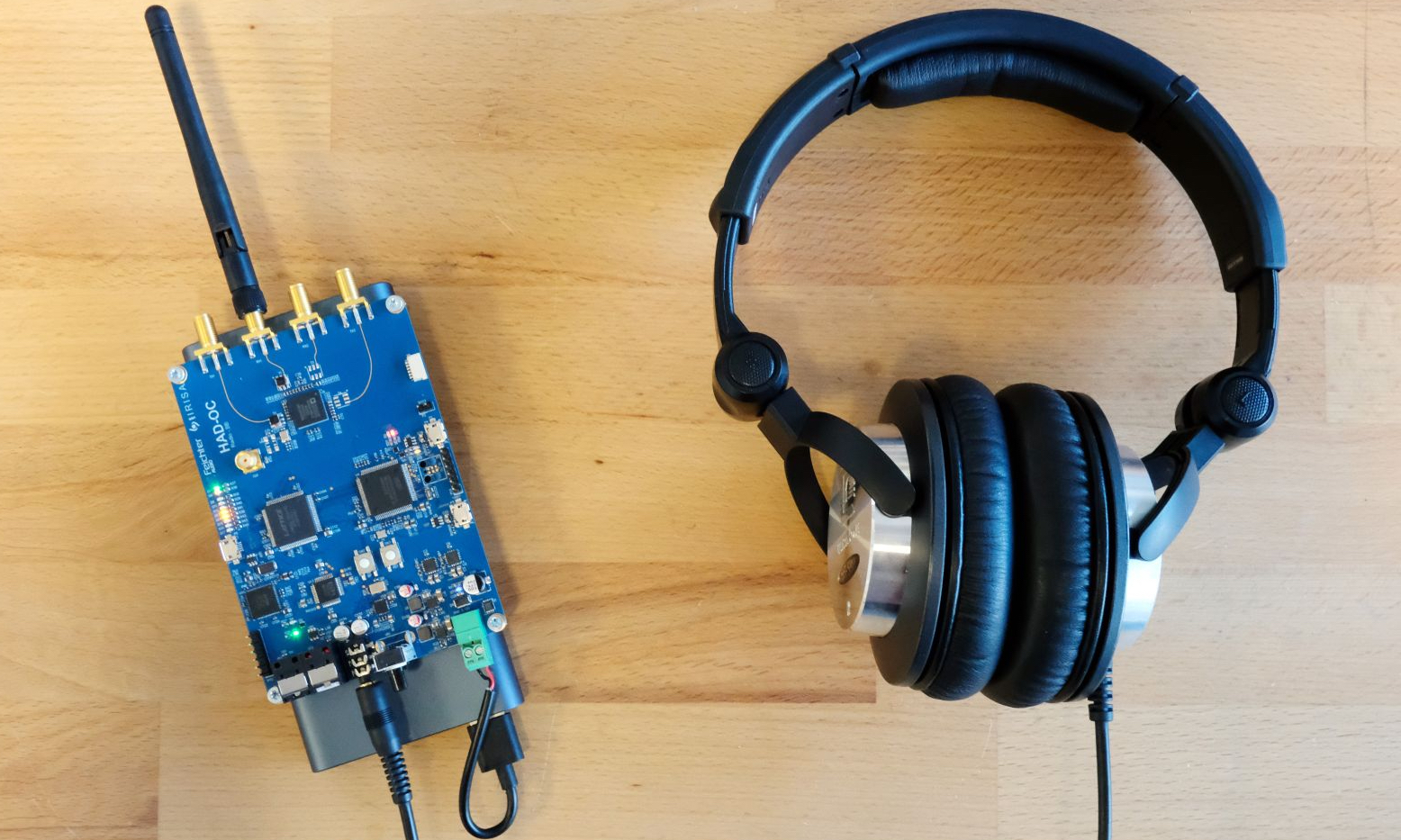
The research leading to these results received funding from the French Brittany Region (Pole Image et réseaux) and Lannion Tregor Communauté through the APP-PME HAD-OC.
Information systems are now massively integrated into both industry and administration processes. Thus, their security is matter of importance especially when considering the storing and exchange of sensitive data. Sensitive data is also called "red" data, in opposition with the non-sensitive (or protected by encryption) "black" data. This crucial challenge is present at multiple scales, and leads to the emergence of different security fields linked to data protection (defense protocols) and to data interception (attack protocols)
Since few years, a new threat has emerged with the detection of the red data due to unwanted phenomena. This attack is done trough an over the air interception and thus is difficult to detect. These kind of attacks (called TEMPEST attacks by the NSA) consist in detecting an hidden channel that bear the sensitive information and then decode the "red" information . This unwanted channel may exist due to different physical phenomena such as electro-magnetic coupling, radio frequency leakages, or mechanical mechanisms. Many studies has been conducted in order to detect and decode "red" information when the leaking channel is stationary. Open questions remain when the leaking channel is sporadic.
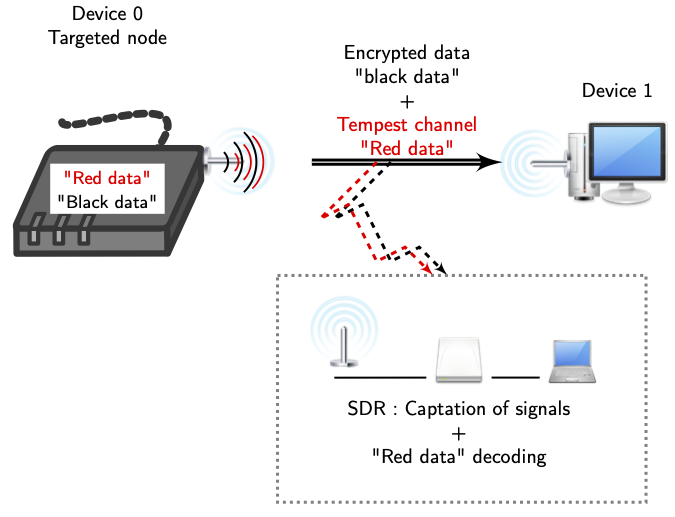
The purpose of the PhD thesis of Corentin Lavaud (2018-2021) was to detect a potential security threat when the leaking channel is sporadic (for instance WiFi) in a real time proof of concept. In this case, it is necessary to propose real time high performance methods trough the use of hardware acceleration. A compact approach trough the use of Software Defined Radio (SDR) has been proposed. This architecture is capable to extract information on 200MHz bandwidth in real time and several exploits have been made. We have for instance shown that commercial Bluetooth devices suffers from TEMPEST channels and that information can be retrieve (PWM actions, audio signals...) passively by listening to the Bluetooth transmissions.
Optical network has to cope with various configuration and agile network deployment is envisioned to address the increasing growth in data rate and spectral efficiency. Nowadays, optical receivers are still based on coherent detection supported by advanced digital processing techniques. These algorithms are designed in order to compensate the harsh effects of optical transmissions; non linearity and impairments induced by the analog chain.
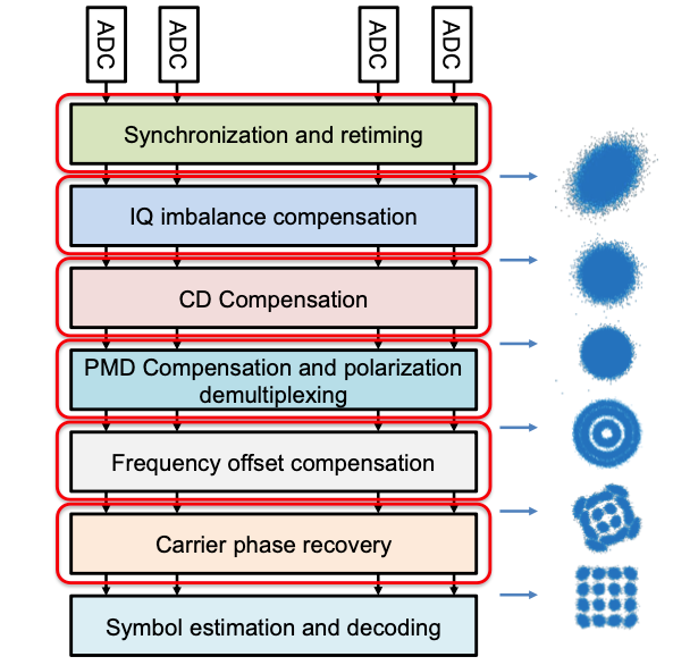
The objective of the thesis of Marwa Kazdoghli Lagha is to propose and study efficient architectures dedicated to high data rate optical transceivers, in order to enhance the spectral efficiency and the flexibility of the system. A particular glance has been dedicated to the digital baseband algorithms for multipolarization operations and channel and hardware impairments compensation (phase noise, chromatic dispersion, ...). We have also a validated the performance on real signals on PERSYST optical platform through the SENDATE CELTIC project.
The future generations of wireless networks (a.k.a 5G) will have to cope with a high degree of heterogeneity in terms of services (Broadband, machine type communications (MTC), Internet of Things (IOT), Vehicular to vehicular (V2V) . . . ) and requirements (high data rates, low latency, high reliability, coexistence, . . . )
Even though Cyclic Prefix Orthogonal Frequency Division Multiplexing (CP-OFDM) is the most prominent multi-carrier modulation technique in wireless standards for below 6GHz transmission (used in 4G, DVB-T, Wifi, . . . ), it also exhibits some intrinsic drawbacks. These limitations make CP-OFDM poorly appealing for 5G and have motivated the study and the comparison of alternative waveforms such as Universal-Filtered OFDM (UF-OFDM) or Filter Bank Multicarrier (FBMC).
We have introduced a new quasi-orthogonal waveform called Block-Filtered OFDM (BF-OFDM) that combines most of the advantages of the aforementioned waveforms at the price of slight complexity increase. Spectral localization and performance in multi-user scenario is enhanced w.r.t OFDM and simple equalization as well as all classical MIMO schemes can be straightforwardly considered. The proposed waveform is scalable and can be used in various configurations and services, which paves the way for future heterogeneous systems.
This waveform has been studied in the scope of mmMagic and Fantastic-5G H2020 projects and in the french ANR WONG-5. The initial proposal has won the 2017 International Conference on Communication (ICC-2017) best paper award.
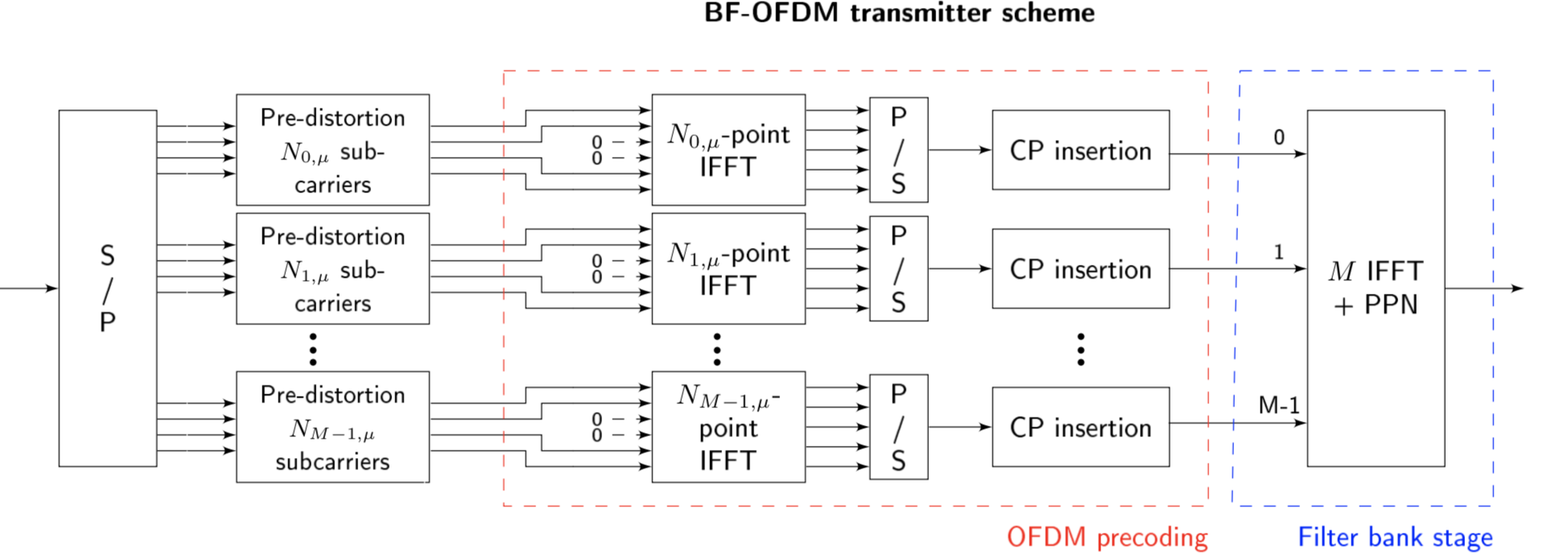
Multi-service transmissions are expected in the upcoming fifth-generation (5G) of cellular networks. These heterogeneous applications lead to many constraints that need to be addressed in a flexible way. We have investigated the division of the bandwidth into several subbands, each having a different service and numerology. This work highlights and demonstrates the possible coexistence of Broadband (eMBB), Ultra-Reliable Low-Latency (uRLLC) and new IoT (eIoT) services within the same channel using a flexible waveform. Field test experiments have been done with an implementation of the BF-OFDM physical layer on prototype hardware boards. These field trials have been made in Minatec Campus in Grenoble and use the new 5G 3.5GHz band.
